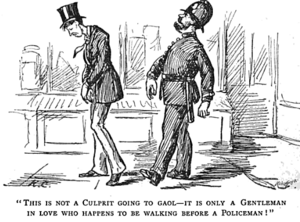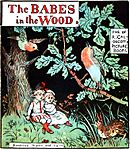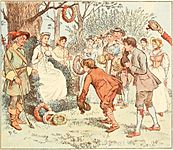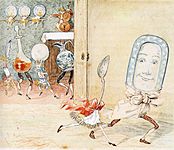Randolph Caldecott facts for kids
Quick facts for kids
Randolph Caldecott
|
|
|---|---|
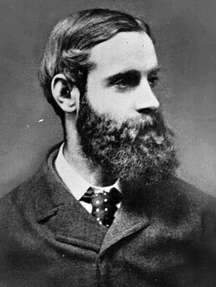
Randolph Caldecott
|
|
| Born |
Randolph Caldecott
22 March 1846 Chester, England
|
| Died | 12 February 1886 (aged 39) St. Augustine, Florida, U.S.
|
| Nationality | English |
| Education | Manchester School of Art |
| Known for | Children's illustration |
|
Notable work
|
The House That Jack Built The Diverting History of John Gilpin Three Jovial Huntsmen A Frog He Would A-Wooing Go |
Randolph Caldecott (born March 22, 1846 – died February 12, 1886) was a famous British artist and illustrator. He was born in Chester, England. The well-known Caldecott Medal, an award for children's books, is named after him.
Caldecott was best known for his amazing book illustrations. The Royal Academy quickly recognized his artistic talent. He had a huge impact on how children's books were illustrated in the 1800s. For eight years, two of his illustrated books were released every Christmas. They were very popular!
Besides children's books, Caldecott also illustrated novels and travel stories. He created funny drawings about hunting and fancy life. He even drew cartoons and sketches of the Houses of Parliament. His paintings and sculptures were shown in important galleries.
Contents
Randolph Caldecott's Early Life
Randolph Caldecott was born in Chester, England, at 150 Bridge Street. His father, John Caldecott, was an accountant. Randolph was the third child of his father's first wife, Mary Dinah Brookes. In 1848, his family moved to Challoner House. Later, in 1860, they moved to 23 Richmond Place in Boughton, a village near Chester.
From a very young age, Randolph loved to draw and make models, especially of animals. He went to King's School, Chester, a grammar school, for five years. He left school when he was fifteen. In 1861, his first drawing was published! It was a sketch of a big fire at the Queens Railway Hotel in Chester. This drawing, along with his story of the fire, appeared in the Illustrated London News.
After school, Caldecott started working as a clerk at a bank in Whitchurch, Shropshire. He lived in Wirswall, a nearby village. When he ran errands, he would walk or ride around the countryside. Many of his later drawings show buildings and scenes from Cheshire and Shropshire.
Randolph loved riding horses, which led him to enjoy fox hunting. His experiences with hunting and his love for the chase later inspired many of his humorous drawings and sketches of hunting scenes.
Moving to Manchester
After six years in Whitchurch, Caldecott moved to Manchester. He worked at the main office of the Manchester & Salford Bank. While there, he studied at night at the Manchester School of Art. He kept practicing his art and found success in local newspapers and some London magazines.
Randolph had a habit of drawing small sketches on his letters and papers. These drawings would either explain what he was writing or just add some fun. Many of his illustrated letters have been printed in a book called Yours Pictorially. In 1870, a painter friend named Thomas Armstrong introduced Caldecott to Henry Blackburn. Blackburn was the editor of London Society magazine, and he published many of Caldecott's drawings.
Life in London
Because his art was doing well, Caldecott decided to leave his bank job and move to London. He moved there in 1872 when he was 26 years old. Within two years, he became a successful illustrator, working on different projects.
His work included single sketches and illustrations for articles. He also drew a series of pictures about a trip he took with Henry Blackburn to the Harz Mountains in Germany. This was the first of many such travel illustration series.
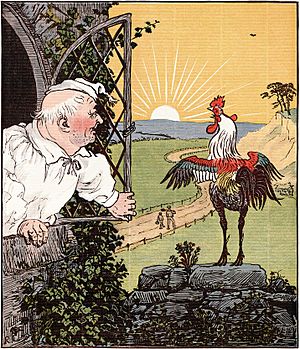
Caldecott lived in London for seven years, mostly at 46 Great Russell Street, right across from the British Museum. He easily made friends with many artists and writers. Some of his friends included Dante Gabriel Rossetti, George du Maurier (who also drew for Punch), John Everett Millais, and Frederic Leighton. His friendship with Frederic Leighton led to a special job: designing peacock decorations for columns in Leighton's beautiful home, Leighton House.
In 1869, Caldecott showed a picture at the Royal Manchester Institution. His first picture was shown at the Royal Academy in 1876. He was also good at painting with watercolors and became a member of the Royal Institute of Painters in Water Colours in 1882.
In 1877, Edmund Evans, a top color printer, asked Caldecott to illustrate two Christmas books. Evans had previously worked with another famous illustrator, Walter Crane. Caldecott's books, The House that Jack Built and The Diverting History of John Gilpin, were published in 1878. They were an instant hit! Because of their success, Caldecott created two new books for Evans every year until he passed away. Many of the original wooden blocks used for printing these books are still kept at St Bride Library in London. Caldecott chose all the stories and rhymes himself, and sometimes he even wrote or added to them.
Caldecott also illustrated books for other authors, including two by Washington Irving and three for Juliana Ewing. Famous artists like Gauguin and Van Gogh admired his work. Randolph kept traveling, partly for his health. He would draw the people and places he visited, adding funny captions and stories to his drawings.
Marriage and Later Life
In 1879, Randolph Caldecott moved to a house called Wybornes near Kemsing in Kent. There, he got engaged to Marian Brind, who lived about seven miles away. They got married on March 18, 1880, and lived at Wybornes for two years. They did not have any children.
In the autumn of 1882, the Caldecotts moved from Kent and bought a house called Broomfield in Frensham in Surrey. They also rented a place at 24 Holland Street in Kensington. By 1884, Caldecott's Nursery Rhymes books were incredibly popular, with 867,000 copies sold across twelve books. He was famous all over the world!
Randolph Caldecott's Death

Randolph Caldecott was often sick. He suffered from stomach problems and a heart condition that started when he was a child. His health was one reason he often traveled to warm places like the Mediterranean during the winter.
In 1886, he was on a trip to the United States when he became ill again and passed away. He and Marian had sailed to New York and then traveled to Florida. It was an unusually cold February. Randolph became very sick and died in St. Augustine. He was not quite 40 years old. A headstone marks his grave in the cemetery there.
Soon after he died, his many friends helped create a memorial for him. It was designed by Sir Alfred Gilbert and placed in the crypt of St Paul's Cathedral in London. There is also a memorial to him in Chester Cathedral.
Why Randolph Caldecott Was Special
Gleeson White, a writer, said that Caldecott was a great artist who could tell stories with pictures instead of words. White noted that Caldecott's drawings for simple texts showed "endless subtleties of thought." He added that Caldecott studied his subjects very carefully and then drew them simply and powerfully.
G. K. Chesterton, another famous writer, wrote a poem about Caldecott's picture books:
This is the sort of book we like
(For you and I are very small), With pictures stuck in anyhow, And hardly any words at all. . . . You will not understand a word Of all the words, including mine; Never you trouble; you can see, And all directness is divine—
Stand up and keep your childishness: Read all the pedants’ screeds and strictures; But don’t believe in anything That can’t be told in coloured pictures.
Maurice Sendak, a famous children's book author and illustrator, believed that Caldecott's work was the start of the modern picture book. Sendak said Caldecott cleverly put pictures and words together in a new way. Sometimes, words were left out, but the picture told the story. Other times, pictures were left out, but the words explained everything. Sendak also liked the "subtle darkness" in Caldecott's work. He felt that even in happy stories, there was a hint of sadness, "like a shadow passing quickly over," which gave Caldecott's books unexpected depth.
Gallery of Randolph Caldecott's Art
-
Cover of Babes in the Wood
-
"In Islington there lived a man/Of whom the world might say/That still a godly race he ran" – illustration from Oliver Goldsmith's An Elegy of the Death of a Mad Dog
Here are some of the famous books Randolph Caldecott illustrated:
- The House that Jack Built (1878)
- John Gilpin (1878)
- Elegy on a Mad Dog (1879)
- The Babes in the Wood (1879)
- The Three Jovial Huntsmen (1880)
- Sing a Song of Sixpence (1880)
- The Queen of Hearts (1881)
- The Milk-Maid (1882)
- Hey-Diddle-Diddle and Baby Bunting (1882)
- The Fox Jumps Over the Parson's Gate (1883)
- A Frog He Would A-Wooing Go (1883)
- Come, Lasses, and Lads (1884)
- Ride A-Cock Horse to Branbury Cross & A Farmer went Trotting Upon his Grey Mare (1884)
- Mrs. Mary Blaze (1885)
- The Great Panjandrum Himself (1885)
- Complete Collection of Pictures and Songs (1887) From the Collections at the Library of Congress
See also
 In Spanish: Randolph Caldecott para niños
In Spanish: Randolph Caldecott para niños


